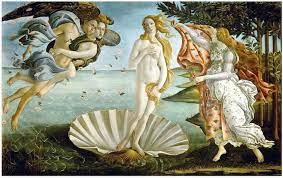Classical Blog Exhibit
Revolution and Art: A Virtual Exhibit on the Interplay of Political Change and Artistic Expression in the 1700s
Introduction:
The 1700s was a period of revolutionary change, marked by
huge political changes, social changes, and the rise of new artistic styles.
The era saw the birth of strong movements and ideas that opposed the
established authority of monarchies and the Church, including the
Enlightenment, the American Revolution, and the French Revolution. The
classical era in Western art emerged during this period, which was marked by a
rise in interest in the ideals of classical Greece and Rome, a buildup on
harmony, balance, and proportion, as well as the exploration of new subjects
and topics. It was also a period of profound artistic innovation.
By highlighting three important works by three different
classical artists from the 1700s—Jacques-Louis David's "The Death of
Marat" (1793), Francisco Goya's "The Third of May 1808" (1814),
and John Singleton Copley's "Watson and the Shark"—this virtual
exhibition seeks to examine the interaction between revolution and art in the
era (1778). The exhibit looks at these pieces in an effort to show how the
revolutionary beliefs and events of the time were represented in the arts and
how artists were key to influencing and expressing the spirit of the moment.
Revolution and Art in the 1700s:
During the 1700s, there was a lot of political and social
development. The Enlightenment, a movement that placed a strong focus on reason,
individuality, and science, called into question the traditional power of
monarchies and the Church and pushed for the creation of a society that was
more just and logical. Both the French Revolution (1789–1799) and the American
Revolution (1775–1783) saw the fall of long-standing monarchs in favor of more
democratic forms of governance. The arts were greatly impacted by these
revolutionary events as artists tried to capture the spirit and support the
revolutionary cause by their creations.
A lot of political and social change occurred throughout the
1700s. The Enlightenment challenged the established authority of monarchies and
the Church and advocated for the development of a society that was more
rational and based on reason. It also placed a heavy emphasis on reason,
individuality, and science. Long-standing monarchies were destroyed during the
French Revolution (1789–1799) and the American Revolution (1775–1783) in favor
of more democratic systems of government. These revolutionary events had a significant
impact on the arts as artists strove to capture the spirit and advance the
revolutionary cause by their works.
Revolutionary
Themes in Selected Works:
Jacques-Louis David's "The Death of Marat"
(1793)
A French painter of the classical era who strongly
backed the French Revolution was Jacques-Louis David. The assassination of
Jean-Paul Marat, a radical writer and politician who was a significant
participant in the Revolution, is mostly on in his 1793 painting "The
Killing of Marat" (The Death of Marat). Seen as a symbol of the
revolutionary cause, Marat's lifeless body is depicted in the artwork as an
iconic example of suffering and sacrifice. David's artwork displays his
dedication to the revolutionary principles by capturing the fury and bloodshed
of the time.
Francisco Goya's "The Third of May 1808" (1814)
A Spanish painter of the classical era, Francisco Goya was
renowned for his original and expressive technique. The Peninsular War, a
smaller war that was a portion of the greater Napoleonic Wars, which were
itself an outgrowth of the revolutionary spirit that had swept Europe, is shown
in "The Third of May 1808" (1814) in a haunting manner. The savagery
of battle is sharply criticized in Goya's picture, which also emotionally
conveys the suffering and resistance of common people over the government.
John Singleton Copley's "Watson and the Shark"
(1778)
American painter John Singleton Copley enjoyed remarkable
success both in the American colonies and in England. His dramatic portrayal of
a true story in which young sailor Brook Watson was attacked by a shark and afterward
saved by his other crew members is called "Watson and the Shark"
(1778). With Watson representing the scrappiness and bravery of the American
colonists and the shark standing in for the oppressive British authority, the
picture might be read as an allegory of the American struggle for freedom.
Copley's artwork exemplifies the various ways in which artists of the period
attempted to interact with the revolutionary events and concepts that were
reshaping their world.
References
Crow, T. (1985).
Painters and Public Life in Eighteenth-Century Paris. New Haven and London:
Yale University Press.
The connection between art and politics in 18th-century
France is thoroughly examined in this book, with particular attention paid to
the ways in which revolutionary projects were advanced by painters like
Jacques-Louis David. The significance of David's "The Death of Marat"
within the background of the French Revolution is thoroughly discussed by the
author.
Hagen, R. M., & Hagen, R. (1990). Francisco Goya:
The Third of May 1808. In R. M. Hagen & R. Hagen (Eds.),
Francisco Goya, 1746-1828: The Path to Enlightenment (pp. 95-103). Cologne:
Taschen.
In-depth discussion of Francisco Goya's "The Third of
May 1808" and its connection to revolutionary events and thoughts is
provided in this essay. The artwork, according to the authors, powerfully
illustrates the human cost of battle and Goya's own frustration with the
revolutionary cause.




I am so glad you talked about Goya! I have seen that painting in person in Madrid, and the atmosphere around it is unnerving. His composition has been replicated repeatedly to signify conflict in different eras and highlights that the first victims are the innocents.
ReplyDelete